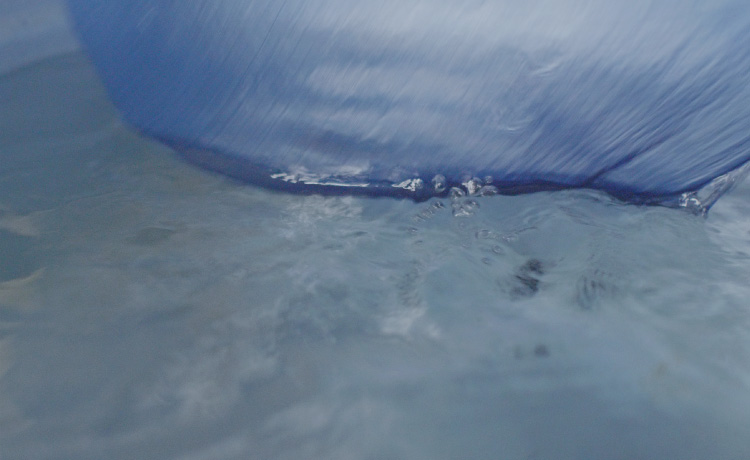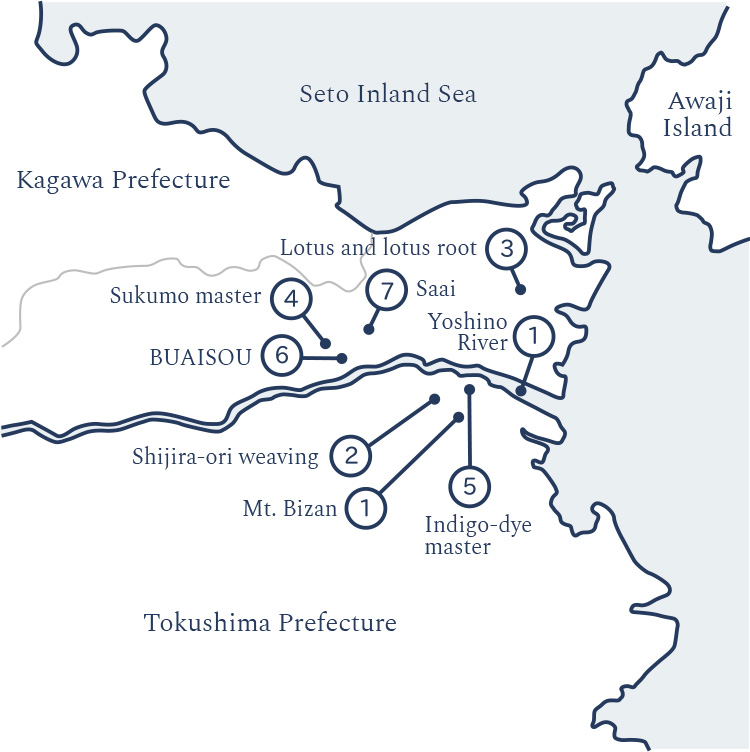



The appeal of Awa no Kuni, Tokushima, colors my soul with each trip.



Mt. Bizan is the symbol of Tokushima City. It is not a tall mountain, but has a beautiful ridgeline that is praised in the Man’yo-shu (A Collection of Ten Thousand Leaves), the oldest collection of poetry in Japan, as having the shape of an eyebrow. Flowing in front of Mt. Bizan, the Yoshino River is so wide you may think for a moment that you are looking at the sea. It is more than two kilometers wide in some places, with the wildest rapids in Shikoku. Reeds, or yoshi, grow along the river bank, which is said to be how it got its name. There was a flock of wild birds at the river, and an unending chorus of their cheery songs filled the air.

A traditional craft since the beginning of the Meiji Period (1868–1912), invented when a woman saw how cloth that had gotten wet in the rain formed little wrinkles, and found a way to weave the warp to achieve the look. Shijira-ori weaving was used for summer kimono, but now there are only two shops that continue this craft. From its factory with a retro-feeling saw-toothed roof, Nagao Orifu still weaves textiles today using traditional looms.

The sight of white and pink lotus flowers blooming in a lotus pond as far as the eye can see makes you feel like you’re in the Pure Land that Buddhism describes. As I was gazing blissfully at the scene, a local informed me that it was a field of lotus roots. Tokushima boasts the second-highest production of the edible lotus root in Japan. The juxtaposition of the beautiful flowers blooming in the practical field was strangely funny.

The artisans who make sukumo are called sukumo masters. There are only five sukumo masters in Tokushima today. Osamu Nii is one of them, and he makes 300 bales of sukumo a year. The factories and creators all around Japan who use Japanese indigo wait every year for Nii’s sukumo. The Japanese indigo hand towel that he always wears wrapped around his head is splendid!

Indigo-dye masters, or indigo dyers, are artisans who dye cloth using sukumo. Toshiharu Furusho is a sixth-generation indigo dyer, whose family business stretches back to the Edo Period (1603–1868). He has a charmingly simple way of speaking and a serious personality. He dyes cloth only using natural ingredients and traditional methods.

BUAISOU is creating a new movement for Awa indigo. Its young creators moved to Tokushima and started growing Japanese indigo, making sukumo, and dyeing cloth themselves. They hold Japanese indigo dyeing workshops in overseas locations like New York City and collaborate with other brands. In speaking with them, they made it clear that everything they do, from cultivating the Japanese indigo to dyeing with it, involves their passion for monozukuri, or the art and craft of making things.

The indigo-dye master Minako Tamura runs a dye studio and is also an artist in her own right. Her husband’s main job is serving as the head priest of a Buddhist temple that has been handed down in his family. The couple grows Japanese indigo in a field behind the temple, which she uses for her meticulous dyeing work. She creates books used to collect stamps at temples and shrines by dyeing Japanese washi paper and drawing patterns on it using glue infused with gold powder. They are exquisite.
職種:店舗販売 / 営業 / 生産管理 / パタンナー / デザイナー
正社員登用、給与は経験により相談。月20万円以上。
年齢性別不問。
厚生年金、健康保険、雇用保険等完備。交通費支給、賞与。
ご希望の方は、メールにて履歴書と職務経歴書をお送り下さい。
通過者のみ面接の返信をいたします。なお募集の職種は時期によって異なる場合があるのでお問い合わせください。
*学生のインターンは随時可能ですので、希望者は面接いたします。
送信先メールアドレス:matohu@lewsten.com
◇ matohuの理念
「日本の美意識が通底する新しい服の創造」をコンセプトに文化や歴史を大切にしながら、現代人の心に響く魅力ある「デザイン」を生み出すこと。それを深い「言葉」で表現し、共感者の輪を拡げて行く「場」を作って行くこと。
この3つを通して、多様で心豊かな世界をともに作り上げることがmatohuのプロジェクトであり、理念です。
◇ 仕事のやりがいと人間的成長
まかされた仕事を自分の創意で工夫していける環境です。1Fはショップ、2Fはアトリエになっており、デザイナーと直接話しながらアイデアを実現していけます。また文化、歴史など幅広い知識を学ぶ機会も多く大人の教養と礼儀が身につき、人間的にも成長できます。
人の心に彩りを添えるデザインを生活のなかに!を合い言葉にこれから世界に向けて発信するmatohuのスタッフを募集します。